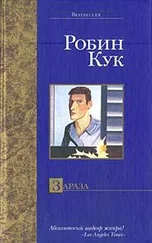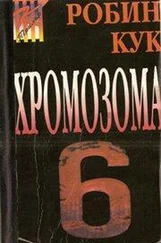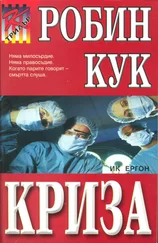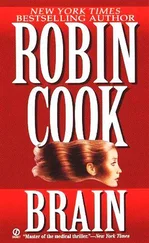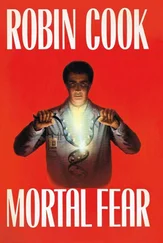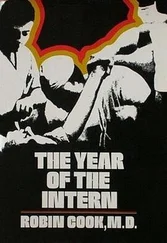The first response came from the wastebasket. It was a very weak reading and totally harmless, but it was nonetheless radiation. Glancing at his watch, Philips noticed that time was slipping rapidly away. In one-half-hour he was going to have to call Denise’s apartment. He decided that he’d present himself only after he’d made sure Sansone wasn’t holding her.
With the positive reading in the wastebasket he decided to go over the lab one more time. He found nothing until he returned to the closet. The lower shelves were filled with linen and hospital gowns, while the upper shelves had a mixture of laboratory and office supplies. Below the shelves was a hamper filled with soiled linen, which registered another weak positive reading when he pushed the probe almost to the floor.
Martin emptied out the soiled linen and went over it with the detector. Nothing. Sticking the probe into the emptied hamper Philips again got a weak response near the base. He reached down and put his hand into the enclosure. The walls and floor of the hamper were painted wood and seemed solid. With his fist he struck the bottom and felt a vibration. Taking his time he hit it all around the periphery. When he got to the far corner the board tilted slightly, then fell back into place. Pushing in the same location Martin raised the floor of the hamper and looked beneath. Below were two shielded lead storage boxes with the familiar radiation warning logo.
The two boxes had labels indicating their origin from the Brookhaven Laboratories, which was a source of all sorts of medical isotopes. Only one of the labels was entirely legible. It contained 2-[18F]fluoro-2 deoxy-D-glucose. The other label was partially scraped off although it was also an isotope of deoxy-D-glucose.
Martin quickly opened the boxes. The first one with the legible label was moderately radioactive. It was the other box which had a significantly thicker lead shield that made the radiation detector go crazy. Whatever it was, it was very hot. Philips shut and sealed the container. Then he piled the linen back into the hamper and shut the door.
Martin had never heard of either one of the compounds, but the mere fact they were in the GYN clinic was reason enough to make them highly suspect. The hospital had extremely strict controls concerning radioactive material that was used for radiotherapy, some diagnostic work and controlled research. But none of these categories was applicable to the GYN clinic. What Philips had to know was what radioactive deoxy-glucose was used for.
Carrying the radiation detector, Philips descended the clinic stairs to the basement. Once in the tunnel system he had to slow his dash in order not to surprise the groups of medical students. But when he reached the new medical school he increased his pace, arriving at the library totally out of breath.
“Deoxy-glucose,” he panted. “I need to look it up. Where?”
“I don’t know,” said the startled librarian.
“Shit,” said Philips and turned and started toward the card catalogue.
“Try the reference desk,” called the woman.
Reversing his direction, Philips went to the periodical section where the reference desk was staffed with a girl who looked about fifteen. She’d heard the commotion and was watching Martin’s approach.
“Quick...” said Philips. “Deoxy-glucose. Where can I look it up?”
“What is it?” The girl eyed Martin with alarm.
“Must be some sort of sugar, made from glucose. Look, I don’t know what it is. That’s why I need to look it up.”
“I guess you could start with the Chemical Abstract and try the Index Medicines, then...”
“The Chemical Abstract! Where’s that?”
The girl pointed to a long table backed by bookshelves. Philips rushed over and pulled out the index. He was afraid to look at his watch. He found the reference as a subheading under glucose, giving him the volume and page number. When he found the article, he started to skim it but his frenzy turned the words into a meaningless jumble. He had to force himself to slow down and concentrate, and when he did he learned that deoxy-glucose was so similar to glucose, the biological fuel of the brain, that it was transported across the blood-brain barrier and picked up by the active nerve cells. But then, once inside the active nerve cells it could not be metabolized like glucose, and piled up. Down at the very bottom of the short article it said: “... radioactively tagged deoxy-glucose has shown great promise in brain research.”
Martin snapped the book shut and his hands trembled. The whole affair was beginning to make sense. Someone in the hospital was conducting experiments in brain research on unsuspecting human subjects! “Mannerheim!” thought Martin, so enraged that he could taste the venom.
He was not a chemist, but he remembered enough to realize that if a compound like deoxy-glucose was made sufficiently radioactive, it could be injected into people and used to study its absorption in the brain. If it were very radioactive, which the stuff in the box in GYN was, then it would kill the brain cells that absorbed it. If someone wanted to study a pathway of nerve cells in the brain they could selectively destroy them with this method, and it was the destruction of nerve pathways in animal brains that had been the foundation of the science of neuroanatomy. To a sufficiently ruthless scientist it was just a step to adopt the same methods to humans. Philips shuddered. Only someone as egocentric as Mannerheim would be able to overlook the moral aspects.
Martin was crushed by his discovery. He had no idea how Mannerheim got Gynecology to participate, but they had to be in on the study. And the hospital administrator had to know something too. Why else would Drake defend Mannerheim, the prima donna neurosurgeon, the demigod of the hospital. Martin sagged under the appalling implications.
He knew that Mannerheim was heavily funded by the government; millions and millions of dollars of public money went into his research activities. Could that be the reason for the FBI’s intervention? Had Martin been accused of endangering a major breakthrough funded by the government? The FBI might have no idea that the breakthrough involved human experimentation. Martin was no tyro when it came to organizational snafus when the right hand had no idea what the left hand was doing. But it was a sorry twist that the use of human sacrifice for medical research could be unknowingly protected by the government.
Slowly Martin turned his wrist to see the face of his watch. Five minutes to go before he had to call Denise. He was not sure if the agents would harm her, but after their treatment of the tramps he was not about to take any chances. He wondered what he could do. He knew something about what was going on... not everything, but something. He knew enough that if he could get some powerful person to intervene, the whole conspiracy might unravel. But who? It would have to be someone outside of the hospital hierarchy, but knowledgeable about the hospital and its structure. The Commissioner of Health? Someone in the Mayor’s office? The Commissioner of Police? Martin was afraid that these people might have already been told so many lies about Martin that his warnings would fall on deaf ears.
Suddenly Philips thought of Michaels, the boy wonder. He could get to the Provost of the university! His word could be enough to stimulate an inquiry. It might work. Martin ran to one of the phones and got an outside line. As he dialed Michaels’ number, he prayed that he’d be home. When the scientist’s familiar voice answered, Martin could have cheered.
“Michaels, I’m in terrible trouble.”
“What’s wrong?” asked Michaels. “Where are you?”
“I don’t have time to explain; I’ve uncovered some gigantic research horror here in the hospital, which the FBI seems to be protecting. Don’t ask me why.”
Читать дальше

